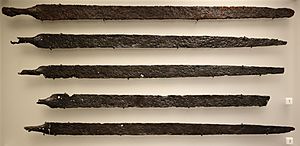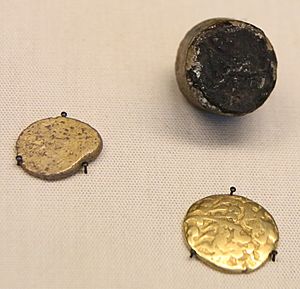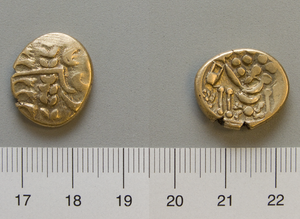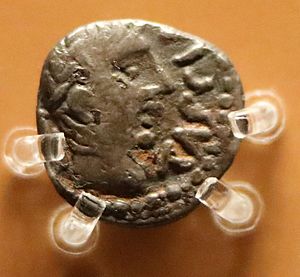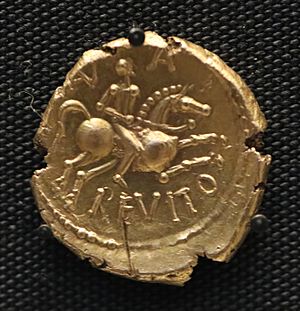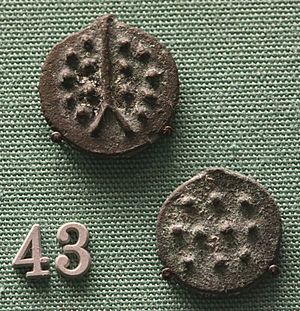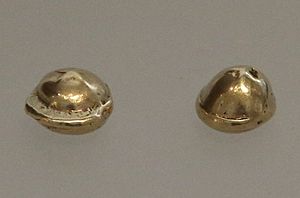Celtic currency of Britain facts for kids
The Celtic currency of Britain refers to the different types of money used in Britain by the Celts from about 200 BC to AD 60. At first, people used iron bars as money. Later, coins started arriving in Britain around 150 BC. The Celts in Britain then began making their own coins around 100 BC.
Making these coins mostly stopped when the Romans invaded Britain. This happened first with the Roman attack in AD 43, and then completely after the defeat of Boudica in AD 60 or 61. Some cast coins might have been made for a few more years near Hengistbury Head. Experts are always learning more, so the exact dates for coins can sometimes change.
Coin use was common in a central area of Britain. This area included places like the home counties, parts of Oxfordshire, Northamptonshire, and Cambridgeshire. Around this central area, other Celtic groups also used coins. Some of these groups, like the Corieltauvi, Durotriges, Dobunni, and Iceni, even made their own coins. The coins in the central area are usually linked to the Atrebates and Cantii tribes south of the River Thames. North of the Thames, they are linked to the Trinovantes and Catuvellauni tribes.
Early Money: Iron Bars and More
The first type of money in Britain was iron currency bars. These started appearing around 200 BC. Iron bars have been found in four main shapes: sword-shaped, spit-shaped, plough-shaped, and bay-leaf-shaped. Some people think these shapes showed where the bars came from. These bars usually weighed between 0.3 and 0.5 kilograms (about 0.6 to 1.1 pounds). Spit-shaped bars are the most common, making up half of all discoveries. Sword-shaped bars are also very common, making up another 40 percent.
The Roman general Julius Caesar wrote about iron bar currency in his book Commentarii de Bello Gallico. There are different versions of his text, so it's possible he was talking about iron rings used as money. However, based on what archaeologists have found, iron bars seem more likely.
In the past, some people thought gold rings were used as money. But newer research suggests this is probably not true. A writer named John Lesley in the 1500s claimed that leather money was used in Scotland in the 2nd century BC. No proof for this claim has ever been found.
Celtic Coins
Coin Names
We don't know the original names the Celts gave to their coins.
Today, experts give coins different names, whether they have writing on them or not. Gold coins are called staters or quarter staters. These names come from ancient Greek coins. Gold staters usually weighed between 4.5 and 6.5 grams. Quarter staters, as the name suggests, weighed about a quarter of a gold stater. A few other gold coins that don't fit these weights are sometimes called gold fractions.
Silver coins are called staters, units, half units, and minims. Units usually weighed between 0.8 and 1.4 grams. Half units were about half that weight. Minims are small silver coins weighing less than 0.4 grams.
Coins made of copper alloys (mixtures of metals) are called staters, quarter staters, and units. Cast staters and potins are special types of these coins.
To be more specific, individual coin types often have catalog numbers. Sometimes, simple descriptions are used. Many different catalogs have been made over the years. Van Arsdell's 1989 catalog is one of the most popular. Because catalogs can overlap, one coin might have many different names!
How Coins Were Made
Most Celtic coins in Britain were made by striking them. This means hitting a metal blank with a hammer between two special tools called dies. A few coins were made by casting, which means pouring melted metal into a mold.
The exact way struck coins were made isn't fully clear. It's thought that a four-step process was used. First, a very precise amount of metal (like powder or a small lump) was weighed. Then, this metal was put into a clay mold and heated to create a blank coin shape. Archaeologists have found examples of these clay molds. Next, the blank was flattened. Finally, it was placed between two dies and struck with a hammer. The bottom die was curved to hold the blank steady. The top die was also curved. Often, the dies were bigger than the blanks, so only part of the design would appear on the coin.
Experiments show that a bottom die could be used to make up to 10,000 coins. Top dies could last from just over 100 strikes to nearly 8,000. Combining old records with archaeological finds, it seems ancient coin makers could get as many as 47,000 strikes from one die.
Sometimes, instead of molds, metal might have been melted and poured onto a flat surface.
Some coins from this time have been found with a cheap metal inside and a thin layer of precious metal on the outside. These were made by covering the cheap metal with a thin layer of gold or silver, then striking it. Most of these were fakes. But some were made using the same dies as real coins, which makes their purpose less clear.
For cast coins, a series of clay molds were connected by small channels called runners. The designs on the coins were made by pressing a pattern into the clay or by scratching lines. Melted metal was then poured into these molds. Once the metal cooled, the molds were broken to get the coins out.
Coins from Other Lands
The very first coins found in Britain from this period are Carthaginian bronze coins from the 3rd or 4th century BC. It's unlikely they were used as everyday money. They might have come to Britain as payment for soldiers who fought for Carthage or Syracuse. Other old coins have been found, but there's no clear proof they were used as currency.
Around 150 BC, Gallo-Belgic staters began to arrive in Britain. These gold coins had designs that came from the staters made by Philip II of Macedon. Philip's coins showed the head of Apollo (a Greek god) wearing a wreath on one side. On the other side, they showed a chariot pulled by two horses, with a figure holding a whip. Six types of Gallo-Belgic staters are known (A through F). Types C through F had the biggest impact on later British coin designs. The making of these coins stopped when the Romans conquered Gaul (modern France). It's possible that some of these coins were made in Britain, not just imported. A die for making Gallo-Belgic A coins was found in Bredgar, Kent. But it's not clear if it was used for real coins or for fakes.
Other coins from mainland Europe have also been found in Britain. Ambiani coins have been found along the south coast of the West Country. They probably arrived there through trade across the English channel.
Potin Coins
Kentish cast bronzes, also called Thurrock potins, seem to be the first coins made in Britain. They date from the late 2nd century BC. They were mainly used in Kent and were based on coins from Massalia (now Marseille in France). Many other potin coins were made, with production ending around 50 BC. These coins were cast (poured into molds), not struck. Even though potins were made at the same time as the first British gold coins, they are not usually found together. This suggests they were used for different purposes in society. Potins continued to be used for some time after the Roman conquest of Britain. They have even been found in burials from the late Roman period.
Coins Without Names (Uninscribed Staters)
The first known British stater was based on the Gallo-Belgic C stater. It seems to have been made by melting down these foreign coins and making new ones. This coin is called the British A stater, or the Westerham and Ingoldisthorpe stater. It was probably made shortly after 100 BC. This coin is often linked to the Atrebates kingdom, but this is not certain.
Around the same time, or soon after, many different British staters were made without names on them. Coins with names didn't appear until after 50 BC. Like the Gallo-Belgic staters, these coins have been divided into different series and types.
| Series | Other Names | First Made | Made by | Mainly Found | Based on | Image |
|---|---|---|---|---|---|---|
| A | Westerham and Ingoldisthorpe | 100 BC or shortly after | Atrebates? | Gallo-Belgic C |  |
|
| B | Chute | 60-50 BC | Durotriges? | Dorset, Wiltshire, Somerset | Gallo-Belgic C |  |
| C | Yarmouth | Hampshire, Isle of Wight | British A | |||
| D | Cheriton | 50-30 BC | Hampshire, Isle of Wight | British B | ||
| F | Clacton | 100 BC or shortly after | ||||
| G | Clacton | 100 BC or shortly after | ||||
| H | North-east coast | 70 BC | Corieltauvi | Gallo-Belgic C | ||
| I | 70 BC | Corieltauvi | Gallo-Belgic C | |||
| J | Norfolk wolf | 50 BC | Iceni | Gallo-Belgic E |  |
|
| K | South Ferriby | 40 BC | Corieltauvi | |||
| L | Whaddon Chase | 50 BC | Cassivellaunus? | Hertfordshire, Buckinghamshire, Bedfordshire, Essex |  |
|
| N | Freckenham | 40 BC | Iceni | |||
| Q | 50 BC | Gallo-Belgic F | ||||
| R | Dobunni | British Q? |
During the Gallic Wars (when Romans fought in Gaul), the weight of gold staters being made dropped a little. At the same time, silver coins started to be made in some areas.
Coins with Names (Inscribed Coins)
North of the Thames
The first coins with names in this area appeared around 35 BC. They are linked to a leader named Addedomarus. These coins included gold staters (based on the British L stater), gold quarter staters, and silver and bronze coins of lower value. Addedomarus's coins were made at the same time as those of Tasciovanus. Tasciovanus also first made staters based on the British L stater. His later coins looked more Roman. This was especially true for his silver and bronze coins. Later in Tasciovanus's rule, coins were made with the names Andoco, Sego, Dias, and Rues. These were made around AD 1. They likely belonged to smaller rulers who worked for Tasciovanus.
Some of Addedomarus's coins had a palm branch design. This design also appeared on the coins of his likely successor, Dubnovellaunus. Like Addedomarus, Dubnovellaunus made silver and bronze coins, but not many.
Tasciovanus's son, Cunobelin, eventually took control of the whole region. His staters also featured the palm branch design, among others. His bronze and silver coins changed over time. They started with Celtic designs and then showed influences from many different Mediterranean coins. Cunobelin's coins might have been the last ones made in this area before the Roman invasion in AD 43. A few coins have been linked to his sons, but this is not certain.
South of the Thames
The first coins with names in this area were made around 30 BC. They were based on the British Q stater. These coins had the name COMMIOS on them. They seem to have been made by the son of a leader named Commius, who Julius Caesar wrote about. It's possible the very first of these coins were made by the original Commius. Only gold staters have the COMMIOS name. But quarter staters and silver coins have been linked to this series. The COMMIOS gold staters were about 47% gold and weighed between 5.3 and 5.5 grams. After Commius, two series of coins seem to have been made by Tincommius and another by Eppillus.
Tincommius first made coins similar to Commius's. But at the end of the 1st century BC, he switched to designs that looked very Roman. These are called the proto-classical series. Tincommius's coins are divided into four series: Celtic, then Proto-classical, followed by Crude and Classical (which were made around the same time). Tincommius made silver coins as well as gold. His Roman-style silver coins seem to have been made from melted-down Roman Denarii. Experts think Tincommius might have had two places where coins were made (mints). This is because of the different styles and how certain designs don't mix. However, where the coins have been found suggests both mints might have been near modern Chichester. Or perhaps one mint was at Calleva Atrebatum. Tincommius's gold staters weighed around 5.3 grams, and his gold quarter staters weighed about 1.03 grams. His silver coins (units) weighed between 1.14 and 1.32 grams, while silver minims were around 0.3 grams.
Eppillus seems to have controlled land in two different areas. He made different coins in each area. For example, the gold coins Eppillus made near Calleva Atrebatum were thicker than those from his lands in northern Kent. The silver coins were also heavier. The style of the coins suggests different artists (die cutters) worked in each region. A few times, an artist from one region made a die for the other. The coins made near Calleva Atrebatum were quite different from earlier styles. But some designs came from Tincommius's coins and various Roman denarii. A single stater found in Dover has Eppillus's name and another unknown name, Anarevito. A few coins found in Kent seem to have been made together by Eppillus, Tincommius, and a third leader named Verica. The style of these coins is similar to those from Eppillus's northern Kent lands, suggesting they might have used the same die cutter.
Eppillus and Tincommius seem to have lost their lands to Verica. From about AD 10, Verica made gold staters and quarter staters based on those of Tincommius and Eppillus. Different styles of coins suggest Verica had two mints. One used an artist who used to work for Eppillus, and the other used an artist from Tincommius. Verica's staters weighed between 5.27 and 5.29 grams. Their gold content was stable, between 42% and 44.5%, meaning the quality didn't get worse over time. Verica also made silver coins, both units and minims. Like his staters, these coins used many Roman designs. In the AD 30s, Epaticcus made staters, silver units, and minims in an area around Silchester. The making of British coins in this area stopped with the Roman conquest of Britain in AD 43.
North of the Core Area
The first coins with names in this area seem to have been made by the Corieltauvi around AD 1. They were very similar to the earlier British K stater. These coins had the letters VEP on them. It's thought that this and other writings refer to the names of leaders. These were followed by coins with AVN AST or AVN COST. After these, the timeline becomes unclear. It's possible that at times, several groups were making coins. The usual coin types were staters, silver units, and silver half units. However, some of the rarer names haven't been found on all coin types.
The other main tribe in this region was the Iceni. They started making coins with names around AD 20. Their coins were quite creative and kept strong Celtic designs until their very last ones. It's not clear who or what most of the names on the coins refer to. Some suggest ECEN is a version of Iceni, but this doesn't fit with how Celtic coins usually had names on them. The last coins made by the Iceni seem to be those of Prasutagus. Unlike earlier Iceni coins, these show a lot of Roman influence in their design. The defeat of the Iceni and the end of Boudicca's revolt in AD 60 or 61 stopped Iceni coin production.
West of the Core Area
Two tribes in this area made coins: the Dobunni and Durotriges. Their coin designs tended to be quite traditional and showed little Roman influence.
The first Dobunni coins with names were those marked BODVOC and CORIO. These were likely made by leaders named Bodvoc and Corio. The exact timeline is unclear, but CORIO seems to have started making coins around 30 BC. It's possible that Bodvoc and Corio ruled different parts of the Dobunni land at the same time. During this period, the Dobunni mostly made silver coins. Gold coins were made only sometimes. Bodvoc and Corio seem to have been followed by Comux and Catti. Again, the timeline is unclear, and they might have ruled different areas. Of these four, only Bodvoc seems to have made silver coins with names. The others might be linked to various silver coins without names that were made in the area. Comux and Catti seem to have been followed by Anted and Eisv, probably in that order. Unlike the earlier leaders, they did make silver coins with names. A branched symbol appears on one side of many Dobunni gold staters. What this symbol means or where it came from is not clear. Some ideas include corn, ferns, or a design from the wreath on the British Q stater.
The Durotriges made a series of coins that quickly lost their value during this time. This probably started around 50 BC with a mostly silver (80%) stater (British B) that had only a small amount of gold. Some think the tribe simply didn't have much gold at this point. Because not many coins have been found in clear archaeological sites, it's hard to be sure about linking some early coins to the Durotriges. So, true Durotrigian coinage might have started a few years later. No matter when it started, the amount of silver in Durotrigian coins quickly dropped. By 30 BC, their coins were being made of bronze. Somewhere between AD 10 and 40, the Durotriges seem to have made a silver coin with the name CRAB on it. The very last Durotrigian coins were cast bronze coins. These have mostly been found near Hengistbury Head. They have been found with Roman coins. It seems possible they were made after the Roman conquest, but why they were made and allowed is unclear. Coin making stopped by AD 100.
Scotland and Wales
No coins were made in Wales or Scotland during this period. As of 2015, only 35 Celtic coins had been found in Wales. Nearly half of these were made by the Dobunni. In the early 2020s, a collection of 15 more coins made by the Corieltavi was found near Llangoed on Anglesey.
As of 1997, only 7 Celtic-era coins had been found in Scotland. Five of these are not well recorded or could be modern losses. Of the remaining two, one is a single South Ferriby stater found in Lauderdale. The other is a collection found near Netherurd. It contained over forty Globules à la Croix (bullet coins) along with some gold torcs (necklaces). These coins were made in Gaul, possibly north-east of Paris, though the exact area is unclear. These types of coins were first made around 200 BC but were used until the Roman occupation. Some people think their presence in Scotland is because of direct political or military contact.
After the Celts
When the Iceni were defeated and their land taken over, the making of Celtic coins stopped. The cast coins from Hengistbury Head might have continued for a few more years. Some coin production, though not clearly official, had already started again in areas the Romans had taken over. After the first Roman invasion in AD 43, low-quality copies of Roman asses seem to have been made. This was possibly to make up for a lack of small coins coming from Roman mints. This seems to have stopped by the AD 70s.
More coin production, again not clearly official, happened around the year 200. This involved making cast copies of silver denarii. Official coin making didn't start again until Carausius set up mints after his revolt in 286.
Celtic coins have been found in archaeological sites that date long after they stopped being made. For example, a single silver coin was found with 4 sceattas (another type of coin) near Birchington-on-Sea. This find has been dated to around AD 600.


